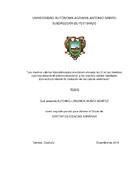Mostrar el registro sencillo del ítem
Los machos cabríos fotoestimulados mantienen elevada la LH en las hembras caprinas durante el anestro estacional, y los machos cabríos familiares (conocidos) inducen la ovulación en las cabras anéstricas
| dc.contributor.advisor | Delgadillo Sánchez, José Alberto | |
| dc.contributor.author | Muñoz Benitez, Alfonso Longinos | |
| dc.contributor.other | Duarte Moreno, Gerardo | |
| dc.contributor.other | Keller, Matthieu | |
| dc.contributor.other | Zaragoza García, Angel | |
| dc.contributor.other | Flores Cabrera, José Alfredo | |
| dc.contributor.other | Hernández Hernández, Horacio | |
| dc.contributor.other | Vielma Sifuentes, Jesús | |
| dc.date.accessioned | 2017-10-05T16:47:03Z | |
| dc.date.available | 2017-10-05T16:47:03Z | |
| dc.date.issued | 2016-12-01 | es_MX |
| dc.identifier.uri | http://repositorio.uaaan.mx/xmlui/handle/123456789/42380 | |
| dc.description.abstract | "En cabras, la presencia permanente de machos convertidos sexualmente activos mediante tratamientos fotoperiódicos, previene la aparición de anovulación estacional y la introducción de estos machos sexualmente activos inducen ovulaciones durante el anestro estacional. Usamos cabras ovariectomizadas con implantes subcutáneos rellenos o no con estradiol para determinar 1) si la presencia permanente de machos sexualmente activos previene la disminución de LH durante el anestro estacional, y 2) si la introducción de machos fotoestimulados aumenta las concentraciones plasmáticas de LH durante el anestro estacional En el Experimento 1, utilizamos cabras ovariectomizadas con implantes subcutáneos de 12 mm que contienen estradiol (OVX + E2). Un grupo de cabras (n = 13) permaneció en contacto permanente con dólares naturalmente activados (noviembre-enero) o estimulados sexualmente (febrero-mayo); el otro grupo (n = 13) permaneció en contacto permanente con palos de control que mostraron un comportamiento sexual intenso (noviembre de enero) o débil (febrero-mayo). Las concentraciones plasmáticas de LH fueron altas y no difirieron entre los grupos de noviembre a enero (P> 0.05), cuando el control mostró un comportamiento sexual intenso. Posteriormente, las concentraciones de LH disminuyeron desde marzo (P <0.05), y permanecieron bajas hasta mayo, cuando los machos de control mostraron un comportamiento sexual débil. Por el contrario, las concentraciones de LH no disminuyeron y permanecieron altas de marzo a mayo en cabras en contacto con los dólares fotoestimulados (P> 0.05). En el Experimento 2, dos grupos de mujeres (n = 6 cada una) que llevaban implantes subcutáneos vacíos de 12 mm estuvieron expuestos, durante el anestro estacional, a los baches controlados o fotoestimulados; otros dos grupos (n = 6 cada uno) que llevaban implantes subcutáneos de 12 mm llenos de estradiol, también estuvieron expuestos al control o a los baches fotoestimulados. Las concentraciones plasmáticas de LH no aumentaron en cabras con implantes vacíos, cuando se las expuso al control (de 2,01 ± 0,26 a 1,98 ± 0,31 ng / ml) o de bazos fotoestimuladas (de 2,45 ± 0,29 a 2,42 ± 0,21 ng / ml; P> 0,05). En contraste, las concentraciones plasmáticas de LH aumentaron (de 0.97 ± 0.41 a 2.80 ± 0.62 ng / mL) en cabras." | |
| dc.format | ||
| dc.language | Español | es_MX |
| dc.publisher | Universidad Autónoma Agraria Antonio Narro | |
| dc.rights | Acceso Abierto | |
| dc.rights.uri | CC BY-NC-ND - Atribución-NoComercial-SinDerivadas | |
| dc.subject | CIENCIAS AGROPECUARIAS Y BIOTECNOLOGÍA | |
| dc.subject.other | Caprine | |
| dc.subject.other | Reproductive seasonality | |
| dc.subject.other | Estradiol feedback | |
| dc.subject.other | Sexual behavior | |
| dc.subject.other | Photoperiod | |
| dc.title | Los machos cabríos fotoestimulados mantienen elevada la LH en las hembras caprinas durante el anestro estacional, y los machos cabríos familiares (conocidos) inducen la ovulación en las cabras anéstricas | es_MX |
| dc.type | Tesis de doctorado | es_MX |
| dc.description.abstractEn | "In goats, the permanent presence of bucks rendered sexually active by photoperiodic treatments, prevents the occurrence of seasonal anovulation, and the introduction of these sexually active bucks, induce ovulations during the seasonal anestrus. We used ovariectomized goats bearing subcutaneous implants filled or not with estradiol to determine 1) whether the permanent presence of sexually active bucks prevents the decrease of LH during the seasonal anestrus, and 2) whether the introduction of photostimulated bucks increases the plasma LH concentrations during the seasonal anestrus. In Experiment 1, we used ovariectomized goats bearing 12-mm subcutaneous implants containing estradiol (OVX+E2). One group of goats (n=13) remained in permanent contact with naturally (November-January) or photostimulated, sexually active bucks (February-May); the other group (n=13) remained in permanent contact with control bucks which displayed intense (November January) or weak sexual behavior (February-May). Plasma LH concentrations were high and did not differ between groups from November to January (P>0.05), when control bucks displayed intense sexual behavior. Afterwards, LH concentrations decreased from March (P < 0.05), and remained low until May, when control males displayed weak sexual behavior. On the contrary, LH concentrations did not decrease and remained high from March to May in goats in contact with the photostimulated bucks (P > 0.05). In Experiment 2, two groups of females (n=6 each) bearing 12-mm empty subcutaneous implants were exposed, during the seasonal anestrus, to control or photostimulated bucks; two other groups (n=6 each) bearing 12-mm subcutaneous implants filled with estradiol, were also exposed to control or photostimulated bucks. Plasma LH concentrations did not increase in goats bearing empty implants, when exposed to control (from 2.01 ± 0.26 to 1.98 ± 0.31 ng/mL) or photostimulated bucks (from 2.45 ± 0.29 to 2.42 ± 0.21 ng/mL; P > 0.05). In contrast, plasma LH concentrations increased (from 0.97 ± 0.41 to 2.80 ± 0.62 ng/mL) in goats exposed to the photostimulated bucks and bearing estradiol implants (P < 0.05). We conclude that the permanent presence of sexually active bucks prevented the decrease of plasma LH concentration in OVX+E2 goats during the seasonal anestrus, and that the introduction of the photostimulated bucks increases the plasma LH concentrations in OVX+E2 goats during the seasonal anestrus". | |
| dc.audience | Estudiantes | |
| dc.audience | Investigadores | |
| dc.publisher.place | Torreón, Coahuila, México | es_MX |
